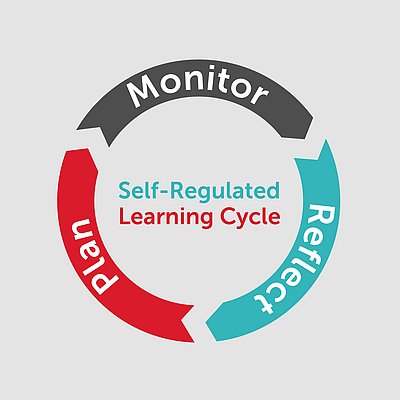Helping students become “Self-regulated learners”
Academic learning is, inherently, a goal-driven pursuit. A student could be motivated to get a good grade, learn the material deeply because they are interested, do enough to get a certificate, advance in their career, or any other reason, but, ultimately, they have a goal in the class. When students keep their focus on their goals, and adaptively adjust their plans, their strategies, their behaviours, they are said to be “self-regulated learners.”
A great deal of research on self-regulated learning has been done, and while there are nuanced differences and areas of focus for different theories and researchers, there are some general ideas that are useful for all educators to be aware of. We’ll cover those, and then provide a few suggestions for helping your learners develop these self-regulated learning skills.
What self-regulated behaviour looks like
Consider Alex, a student in an English Language Learning course. First, Alex engages in planning activities, such as goal setting and time management. For example, they set a clear goal of getting an A in the course, and start breaking that down into more specific goals, such as getting at least 90% of the possible points from homework and setting aside time each week to study for future exams. They then look at their upcoming quiz for the week and make a concrete plan for when they will study for it.
Next, when they begin enacting their plans, they do so actively and monitor. For example, when they sit down to study, they follow through with their plan to begin by making flashcards and studying vocabulary words. They follow it up by trying some practice exercises but quickly realise they are not doing as well on these kinds of questions that require generating new sentences. To address this, Alex re-reads the relevant part of the textbook, looks at the examples there, and creates a small set of new practice questions, to check their (improved) understanding.
Once Alex takes the quiz and learns how they did, they can reflect on their process. Perhaps next time they’ll start by re-reading the textbook before diving in, set aside more time, or make other adjustments to help them get set up for success.

This cycle covered some activities in a small period of time, but you can also envision larger-scale planning, monitoring, and reflection, for a full semester, as well as even more targeted cycles covering a particular 15-minute study session. At whatever grain size, the key is to be actively managing one’s own learning, not treating it as a passive byproduct of listening to your teacher or simply doing your homework.
Ways teachers can help students develop these skills
- Direct instruction: Many students are simply unaware that this approach can be part of a productive, efficient learning routine. Research finds that students generally prefer learning strategies that are actually less effective, such as passively re-reading, compared to spending their time on strategies like self-explanation and practice tests that are more likely to lead to better outcomes. Spending some amount of time introducing students to the idea of thinking deeply about their own learning process can be a worthy investment, particularly if you model some specific steps they can take.
- Modelling: you can walk students through how you would create a plan for working ahead of an upcoming deadline, and “think aloud” about how you approach that planning process. Consider demonstrating the tools and technologies you might use to do that, whether creating a list in a Google doc for yourself, or blocking time off on your calendar. You can also “think aloud” to show students how you go about gauging your own level of understanding, or to take a few minutes to reflect on a study session after it is complete. Depending on the level of your learners, the specific actions you show will be different, but the key is to model that the planning, monitoring, and reflecting are normal and expected parts of the learning process.
- Build steps directly into your course: This is a way of scaffolding students towards becoming more self-regulated. Students are more likely to create a plan for how they will study if it is something you ask them for, and which they can earn points for. Embedding an extra credit question at the end of an assessment that asks students to tell you how they studied can help make them more reflective, and give you insights into your students’ existing self-regulated learning skills. And, it can help you provide compelling evidence to your students, if you indeed find that students who report spending more time engaging in these sort of self-regulated learning activities ultimately score better.
Self-regulated learning supports resilience
This kind of direct instruction and integration of self-regulated learning skills into your course also signals to students how much you value their learning process, not just their performance. By helping your students know what is expected of them, beyond just “doing well,” you can help make students more aware of the behaviours and skills they need to cultivate to help set themselves up for success in your course, and across their academic journey, more generally. In particular, students with these self-regulated learning skills are more resilient in the face of challenges they experience, and are more likely to continue on in their studies.
Explore more strategies to build student resilience in Dan’s whitepaper, “Brave Steps, Bright Horizons: Teacher strategies for supporting resilience In English Language learners”.
About the author
Dan Belenky, Ph.D. is a cognitive scientist with a passion for using learning science research to help educators and learners achieve their academic goals. He has over 15 years of experience researching the psychology of learning, motivation and overcoming challenges, and applying it to the design of educational experiences.

